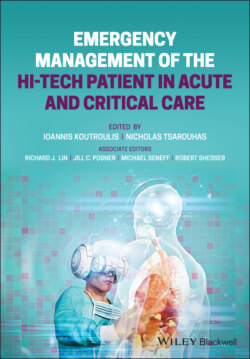Читать книгу Emergency Management of the Hi-Tech Patient in Acute and Critical Care - Группа авторов - Страница 24
Management Routine Care
ОглавлениеEnteral feeding devices require daily care to ensure the tube is patent and to protect the surrounding skin from irritation. All feeding devices need to be flushed with room temperature water following each feed or medication administration to prevent clogging. The tubes should also be monitored for tube deterioration that indicates the tube needs to be changed: discoloration, foul smell, and tube deformity. NG and OG tubes need to be monitored for pressure necrosis at the point of insertion and retaped as needed. Similarly, G‐tubes and GJ tubes can cause pressure ulcers if the tissue between the internal and external retention devices is compressed too tightly. Standard G‐tubes should be turned regularly and evaluated to ensure the external retention device sits 1–2 mm above the skin surface without creating a dimple in the skin. Finally, internal balloon retention devices should be checked regularly to confirm the appropriate amount of fluid is in the balloon to prevent tube dislodgement.
